Hungerford Arcade’s wonderful friend, Stuart Miller-Osborne has come up trumps again with this fascinating article he has written which I hope will fascinate you as much as it did me.
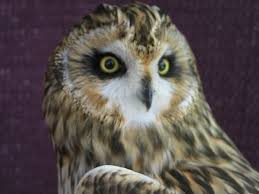 When one enters an antique shop or an Arcade there are three things that will always happen. Firstly, within minutes you will find a copy of The Rubaiyat of Omar Khayyam (usually the Fitzgerald translation). Secondly you will find for sale the Tri-ang lorry you had when you were a child which you managed to batter to destruction before you were twelve. Sadly you note that if you had not been such a horror then you might have been some fifty pounds richer now. Thirdly, you will see an animal or a fish looking startled (or not) in a glass case.
When one enters an antique shop or an Arcade there are three things that will always happen. Firstly, within minutes you will find a copy of The Rubaiyat of Omar Khayyam (usually the Fitzgerald translation). Secondly you will find for sale the Tri-ang lorry you had when you were a child which you managed to batter to destruction before you were twelve. Sadly you note that if you had not been such a horror then you might have been some fifty pounds richer now. Thirdly, you will see an animal or a fish looking startled (or not) in a glass case.
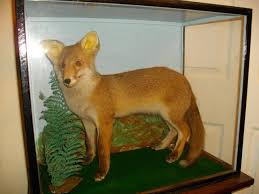 One of the many pleasures of walking down Hungerford High Street (there are many if you look) is that you cannot miss these creatures in their glass cases looking out onto the West Berkshire day. A lot of these are Victorian and I always consider that they are like the H George Wells character in the 1960 movie, The Time Machine. There is a scene in the movie where Wells uses his machine to travel to the future from 1899. Although the machine stays in roughly the same place the world around him changes as the future develops. A Victorian fox looking out onto our High Street will have seen a lot of changes and will do as we progress. Obviously the fox would have been in situ for the last hundred or so years looking at our main street but he is encased in a time capsule which has not changed since he was positioned by our forefathers
One of the many pleasures of walking down Hungerford High Street (there are many if you look) is that you cannot miss these creatures in their glass cases looking out onto the West Berkshire day. A lot of these are Victorian and I always consider that they are like the H George Wells character in the 1960 movie, The Time Machine. There is a scene in the movie where Wells uses his machine to travel to the future from 1899. Although the machine stays in roughly the same place the world around him changes as the future develops. A Victorian fox looking out onto our High Street will have seen a lot of changes and will do as we progress. Obviously the fox would have been in situ for the last hundred or so years looking at our main street but he is encased in a time capsule which has not changed since he was positioned by our forefathers
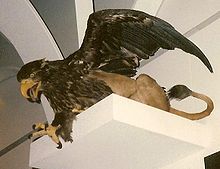
https://en.wikipedia.org/wiki/User:Funkynusayri
This is why taxidermy fascinates me although by no means do I collect. The only time I ever purchased anything in a glass case was when I was eight and at an auction (no less) I spent my pocket money on three butterflies in a small wooden box to the horror of my parents. A year or so later I gave these beautiful creatures a Christian burial at the insistence of my sister who would not look at them when she came into my room. My mother shared the sentiment and I consider that this display would have accidentally been given away if I had not buried them. They still lie at peace in the Wiltshire soil display case and all.
Apart from maybe butterflies I would not collect any other creature. My wife like my sister and mother shudders even at the thought of dead creatures in cases. Any chance that I may have had with my future wife accepting my interest in butterflies and moths was sunk once and for all when as a teenager she was sent a not very well preserved stuffed lizard from her pen friend in the Maghreb. After a week or so in transit the obvious has began to occur and its funeral pyre was quickly arranged.
I was well into my twenties until I began to understand how a taxidermist worked. Previously like a lot of people, I thought that the creature had its internal organs removed and was preserved then later stuffed and glass eyes added. Although I knew this did not apply to insects I could not have been more wrong.
I will not go deeply into the process as you like I have probably recently eaten. But it appears that the creature (which must be a vertebrate) is just skinned and after that is persevered in chemicals (which is a much safer process these days than it used to be) and then mounted on a mannequin which can be made from a variety of materials as is the internal stuffing of the creature.
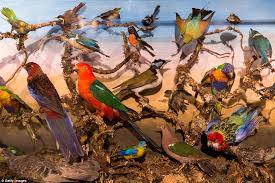 Although I find looking at creatures in glass cases a little haunting, I feel a little uncomfortable when looking at them elsewhere. On a recent visit to the Natural History Museum in Oxford there were quite a large number a birds displayed without cases in the various rooms. For an unknown reason I found this a little sad as the theatre of these creatures seemed to indicate that they wanted to fly and escape into the skies of Oxford. Quite what Inspector Morse would have made of a Golden Eagle perched on the Bodleian is open to question.
Although I find looking at creatures in glass cases a little haunting, I feel a little uncomfortable when looking at them elsewhere. On a recent visit to the Natural History Museum in Oxford there were quite a large number a birds displayed without cases in the various rooms. For an unknown reason I found this a little sad as the theatre of these creatures seemed to indicate that they wanted to fly and escape into the skies of Oxford. Quite what Inspector Morse would have made of a Golden Eagle perched on the Bodleian is open to question.
Although existing prior to the Victorian era, taxidermy really took off during those years.. As my researches indicate it helped to confirm the Western held belief of human superiority over animals. As the Empire grew men left these shores to all parts of the globe, some were hunters who returned with many trophies ready to be mounted. Others were naturalists such as Charles Darwin who travelled the world to study and report on other creatures. Whichever way the tannery business’s were very busy in the nineteenth century. Hungerford is likely to have had one or two at the time.
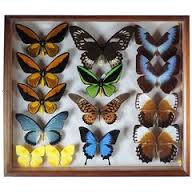 As the taxidermy techniques became more sophisticated, museum collections grew and now nearly two hundred years later we have collections in the United Kingdom and Europe to be proud of. I remember as a child being dragged around various dusty museums and seeing wild animals although long dead as real as you could see them. This made a lasting impression on me although I always looked forward to the collections of butterflies and moths.
As the taxidermy techniques became more sophisticated, museum collections grew and now nearly two hundred years later we have collections in the United Kingdom and Europe to be proud of. I remember as a child being dragged around various dusty museums and seeing wild animals although long dead as real as you could see them. This made a lasting impression on me although I always looked forward to the collections of butterflies and moths.
A big name in the early days of taxidermy was a certain Louis Dufresne (1752-1832) who as a naturalist on board the Astrolabe went on a voyage around the world between 1785 and 1787, during which time he classified an enormous number of creatures. He became the curator and taxidermist at the Museum d’Histoire Naturelle in Paris in 1793 and in 1802 perfected a technique (especially for preserving birds) which advanced the method a great deal. His extensive private collection is now conserved at the Royal Scottish Museum in Edinburgh.
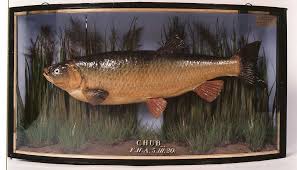 Apart from butterflies and moths one of my favourites are the various fish that you see mounted in cases (often in pubs) where a lucky fisherman, proud of his catch has had his catch stuffed and placed in glass case for posterity. It is the detail that fascinates me .
Apart from butterflies and moths one of my favourites are the various fish that you see mounted in cases (often in pubs) where a lucky fisherman, proud of his catch has had his catch stuffed and placed in glass case for posterity. It is the detail that fascinates me .
Pike caught in Broughton Water 15th of September 1899 by G R Robinson E
sq. or Perch landed by M R Trowbridge at Lacock on the 6th May 1871
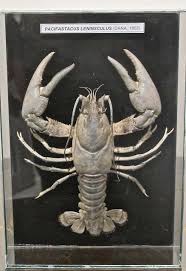 The list is endless but if you are in a pub or elsewhere then they are fun to look at. Whilst on the subject of pubs, there is an interesting one in Beesands in South Devon (near the ruined village of Hallsands). On the wall to the left as you enter is the biggest lobster that you are ever likely to see caught, I believe off of Cape Cod in 1956. The size is awesome especially for a lobster layman such as myself. What further amused me was that in a recent advertisement for the pub that this huge lobster was released from its case and placed on the sea wall with various other items. So near the sea but so far.
The list is endless but if you are in a pub or elsewhere then they are fun to look at. Whilst on the subject of pubs, there is an interesting one in Beesands in South Devon (near the ruined village of Hallsands). On the wall to the left as you enter is the biggest lobster that you are ever likely to see caught, I believe off of Cape Cod in 1956. The size is awesome especially for a lobster layman such as myself. What further amused me was that in a recent advertisement for the pub that this huge lobster was released from its case and placed on the sea wall with various other items. So near the sea but so far.
For a while whilst visiting this establishment, I thought this lobster to be a rouge. This is to say creatures that are not real and are in the realms of imagination. Creatures such as Unicorns and Dragons or long extinct species, but it was real. My researches note that when the Platypus was first discovered in 1798 that it was treated the same way and was thought to be a playful hoax. The people of the time thought a ducks beak had been attached onto an animal resembling a beaver. They were all proved wrong as the Duck Billed Platypus although odd was real enough.
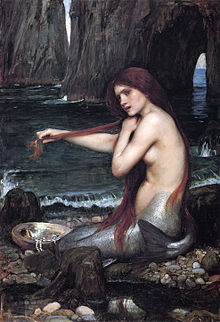 However, if I ever walk down Hungerford High Street or elsewhere and see a mermaid in a glass case then I will most definitely change my choice of ale. For the time being though I will continue to admire the work of these Victorian taxidermists as I peer curiously into these glass cases.
However, if I ever walk down Hungerford High Street or elsewhere and see a mermaid in a glass case then I will most definitely change my choice of ale. For the time being though I will continue to admire the work of these Victorian taxidermists as I peer curiously into these glass cases. 